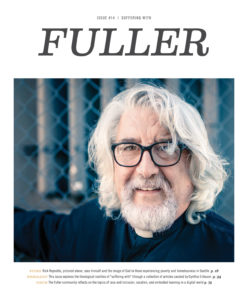
Write “tenderly.” That was the prompting I felt from God as I prayed for the umpteenth time for guidance on how to write this article. I heard it in my heart: “Tenderly.”
Friends, this is a challenging journey.
The call to “suffer with” in the role of pastor, therapist, counselor, or chaplain is one that holds great joy and great sorrow. You have seen the best and the worst of people. The really difficult thing (that likely no one warned you about) is that you cannot go back. You cannot un-hear the stories that you have heard. You cannot un-know the types of evil and abuse that have been perpetrated on people dear to you. You cannot un-see the images of destruction, violence, or mutilation that have been in your gaze. You hold the reality of human life and human pain in your heart.
Depending upon your cultural and social location, the reality of evil and pain may be a challenge in different ways. If you have lived in relative privilege (as I have), you may have insulated yourself from an awareness of vulnerability or threat. Hearing the stories and seeing the pain dismantles that defense. If you are part of a community facing ongoing violence, attending to the needs of your people is a daily task. Taking the time to consider your own pain, or the cumulative impact of so many stories, may feel impossible. Navigating the space of suffering and trauma as a Christian leader in your community—shepherding and teaching, consoling and exhorting, celebrating and praising—can be exhausting.
Our theologies may even contribute to the vulnerability with which we approach suffering. In the human desire to avoid pain, we may create theologies that suggest that God does not want us to feel pain. How did my Protestant, white, middle-class church upbringing teach me that God wanted me to feel good? When did suffering and pain become something that indicated a lack of God’s presence, or a lack of God’s strength?1 The reality is that being human brings suffering. Caring for one’s fellow humans is painful.
The Cost of Suffering With
Henri Nouwen challenges readers to count that cost in his small but powerful book Can You Drink the Cup? 2 When James and John, the sons of Zebedee, press Jesus with their desire for a position of privilege and attention, Jesus asks them, “Can you drink the cup?” (Matt 20:22). Nouwen writes, “Jesus’ cup is the cup of sorrow, not just his own sorrow, but the sorrow of the whole human race. It is a cup full of physical, mental, and spiritual anguish.”3 Nouwen invites the reader to reflect on the actions this question implies: holding, lifting, and drinking the cup in its fullness of joy and suffering. This is not only the suffering that we ourselves face, this is the capacity to drink the suffering of others—to suffer with.
“Drinking the cup” in ministry brings us face to face with stories of unexpected tragedy, human betrayal, abuse, and evil. Hearing the details and caring for the storytellers makes the cup of sorrow personal and deeply painful. Psychologists have noted the extent of this pain. In her seminal book Trauma and Recovery, Judith Herman writes, “trauma is contagious.”4 This contagion of traumatic events can spread as you hear a detailed account and picture the experience. Perhaps it is a young woman sharing about the night she was assaulted on a date. Or maybe it is a man describing what he saw when he regained consciousness in the wreckage of a car accident. The stories draw you in, and you become emotionally, physically, and spiritually engaged.
That engagement can have a cost. It is possible to develop posttraumatic stress disorder just by hearing stories about traumatic events from people we care about.5 The stories can stick, and the pain is real. It may be that these stories are reminders of earlier pain: memories of our own abuse, neglect, frightening events, or loss. It may also be that the accumulation of stories begins to wear down our capacity to process the emotions. The threat of tragedy and violation can become a shadow that colors our lenses on the world. We can begin to store up evidence that the world is not safe or that people are not trustworthy. All of those examples of pain can begin to cloud our ability to see the hopeful possibilities of human kindness, and we start to tell ourselves stories about the need for protection, control, or distance.
Physically, our bodies respond to the sense of threat. Our sleep can be disrupted with nightmares, or we can find ourselves easily irritated and jumpy. We may feel especially revved up or worn out. We might also notice that we avoid people, places, or things that remind us of the tragedies. Ultimately, we might try to avoid the feelings by disconnecting from others or numbing out with overwork, food, the internet, or other substances. Trauma specialists have identified this phenomenon as “indirect trauma,” “vicarious trauma,” or “secondary traumatic stress.”6
Suffering with can break your heart.
 The Skills of Suffering With
The Skills of Suffering With
It is tempting to create a type of wall around our hearts that allows us to hear the story but not feel the feeling. If caring about someone’s life is what opens us up to this pain and vulnerability, then perhaps finding a way to listen—but not to care—is the antidote?
The divine answer to that question is, “No!” Just as Jesus “moved into the neighborhood” (John 1:14, The Message), we are called to “move in” towards the pain. Further, connecting deeply with someone in the midst of suffering can actually become a means of protection against vicarious traumatization.7
Trauma clinicians and researchers suggest that the openness to feeling pain is an important part of working through vicarious trauma. Many of us who have written about resilience to indirect trauma (including myself) have emphasized the things that counselors or pastors can do outside of work time. Good self-care practices, such as healthy eating and exercise habits, and supportive supervisory and peer relationships are an essential part of reducing burnout at work.8 This foundational health is important, as there is evidence that experiencing burnout can make us even more at risk of developing secondary or vicarious trauma symptoms.9 However, in addition to these life balance and health choices, there are important emotional and cognitive skills that contribute to resilience in drawing toward connection with others.
Brian Miller and Ginny Sprang call moving toward the pain a “radical empathy,” which is a genuine empathy that draws us to engage and feel, rather than disconnect and stay at the surface.10 The skill needed in this moment is attention to our own feelings as we are present with others’. Noticing our feelings and naming them are steps to “metabolize” pain.11 When we try to suppress or avoid our feelings, leaving them unexamined and unresolved, we are at risk of bringing those feelings, and the associated physical and cognitive labor, into the rest of our day.
This is not a passive stance in the work of suffering with; rather, experiencing our emotions in this way is actually a skill we can develop. As we pay attention to our feelings, we are also paying attention to our bodily experience. A clenched stomach, tight shoulders, or feeling agitated or jumpy are all signals of our internal state. We can practice taking slow rhythmic breaths, pressing our feet into the floor, and grounding ourselves in the present moment.
Another active skill to practice is attention to rumination. Miller and Sprang note:
The content of ruminations involves a focus on what we are feeling, and is usually a passive re-experiencing of disquieting events. Ruminations often focus on judgments about the events or people involved and the negative aspect of what happened, or what we should have done, or what was so distressful about what someone else did.12
Rumination happens when we let our minds wander. You can hear the temptation to blame the self or others, to grasp at the illusion of control, or to worry. Yet we are called to “capture every thought” (2 Cor 10:5).
To combat rumination, we need to first pay attention and acknowledge when this is happening. Recognize that thinking again and again about a situation is not the same as problem solving (rumination actually reduces our ability to problem solve). Then, a key step in dismantling the ruminative process is to move from passive to active. Capture those wandering thoughts and shift them to active and specific thoughts. What can you do in that moment? It may be an act of advocacy or providing resources. Or, it may be an intentional choice to prayerfully give the situation
to God in lament or intercession. If you find yourself ruminating at other times of day, move to activities that require attention and build positive emotion (such as exercise or a productive hobby) or seek connection in relationships (and avoid isolation).13
As you reflect on the skills and resources you have developed to support the call of suffering with, ask yourself these questions:
- What rhythms of rest and work have you found to sustain yourself?
- What spiritual practices have you adopted to root your very self into the foundation of Christ’s love?
- What friends and colleagues have opened their hearts and ears to your cries of lament and doubt?
- What resources have you discovered that name the pain in language that helps you know you are not crazy?
- What habits do you have to draw you out of rumination?
- Now ask yourself, am I practicing these?
These are not simply questions; they are lifelines.
The Joy of Suffering With
The extraordinary promise in answering the call to “drink the cup” is that it is a cup of both suffering and joy. That is the paradox: in feeling the pain, joining the suffering, or “drinking the cup,” we find comfort and joy. Nouwen writes,
In the midst of the sorrows is consolation, in the midst of the darkness is light, in the midst of the despair is hope, in the midst of Babylon is a glimpse of Jerusalem, and in the midst of the army of demons is the consoling angel. The cup of sorrow, inconceivable as it seems, is also the cup of joy. Only when we discover this in our own life can we consider drinking it.14
The intermingling of suffering and joy is cultivated in the opportunity for mutual comfort and healing. As Paul writes to the Corinthians,
May the God and Father of our Lord Jesus Christ be blessed! He is the compassionate Father and God of all comfort. He’s the one who comforts us in all our trouble so that we can comfort other people who are in every kind of trouble. We offer the same comfort that we ourselves received from God. That is because we receive so much comfort through Christ in the same way that we share so many of Christ’s sufferings. So if we have trouble, it is to bring you comfort and salvation. If we are comforted, it is to bring you comfort from the experience of endurance while you go through the same sufferings that we also suffer. Our hope for you is certain, because we know that as you are partners in suffering, so also you are partners in comfort. (2 Corinthians 1:3–7)
This is an active, healing, mutual transformation. In fact, notice that Paul uses the plural pronouns to remind us that both the comfort and the suffering are communal experiences.15 It is embarrassing to admit that for many years as a white, highly educated, upper-middle-class privileged woman, I held an idea of comfort as though it meant “comfortable.” I functioned out of an expectation that being “comforted” by God would allow me the strength to reach out and be a comfort to others. But what if it is less of a state of being, and more of an active process? By being in the midst of experiencing the comfort of Christ as I am honest and open to the suffering in my own and others’ hearts, I am available to be a channel of Christ’s comfort to others. We are sharing both suffering and consolation (v. 7). By being open to pain, I am open to Christ’s comfort, and in receiving that comfort, I am present to the pain of others.
In the drinking and digesting—metabolizing—of the cup of suffering, we experience the mutuality of joining in relationship. It is only when we are with the sufferer that we are blessed to hear the day-to-day grace, the moments of God’s provision, the gratitude for ordinary miracles, or the internal transformation of character that the Spirit works. As witnesses to this healing, we can also find the strength to bring our own pain to God and others. Through mutuality God’s transforming power continues to shape us.
Remember, though Paul was speaking about all affliction, it was in the context of being disciples of Christ. Living out the gospel brings pain and trial, but it also is rooted in the hope of the kingdom to come. As we suffer with, we are also challenged to consider what action we can take to bring change or justice.16 We are not simply called to comfort and be comforted, we are called to discern the unique ways that God has equipped us to act. We can move from feeling and thinking to acting.
As we suffer with others, we are comforted, invited to transformation, and moved to act in solidarity. The suffering sparks our indignation, the consolation reminds us of the hope of the kingdom coming, and God’s presence brings the joy that sustains us. This is a tender journey of mutual healing that ends with joy.
ENDNOTES
-
Consider the reflections of Kate Bowler in her book Everything Happens for a Reason: And Other Lies I’ve Loved (New York: Random House, 2018). Further, Mark Labberton interviewed Bowler for the Conversing podcast: fullerstudio.fuller.edu/kate-bowler-on-suffering/.
-
H. J. Nouwen, Can You Drink the Cup? (Notre Dame, IN: Ave Maria Press, 2006).
-
Ibid., 39.
-
J. Herman, Trauma and Recovery: The Aftermath of Violence—from Domestic Abuse to Political Terror (New York: BasicBooks, 1992), 140.
-
American Psychiatric Association, Diagnostic and Statistical Manual of Mental Disorders, 5th ed. (Washington, DC: American Psychiatric Association, 2013).
-
For a recent review of literature on these topics see C.B. Eriksson, A. Wilkins, and N. Frederick, “Trauma, Faith, and Care for the Counselor,” in Treating Trauma in Christian Counseling, ed. H. D. Gingrich and F. Gingrich (Downers Grove, IL: Intervarsity Press, 2017).
-
R. L. Harrison and M. J. Westwood, “Preventing Vicarious Traumatization of Mental Health Therapists: Identifying Protective Practices,” Psychotherapy: Theory, Research, Practice, Training 46, no. 2 (2009): 203–219.
-
Additional resources: International Society of Traumatic Stress Studies, www.istss.org/treating-trauma/self-care-for-providers/; Secondary Traumatic Stress Coalition, www.stscoalition.com/; Institute for Collective Trauma and Growth, www.ictg.org/downloadable-guidelines/.
-
K. Shoji et al., “What Comes First, Job Burnout or Secondary Traumatic Stress? Findings from Two Longitudinal Studies from the U.S. and Poland.” PLoS ONE 10, no. 8 (2015).
-
B. Miller and G. Sprang, “A Components-Based Practice and Supervision Model for Reducing Compassion Fatigue by Affecting Clinician Experience,” Traumatology 23, no. 2 (2017): 153–165, 159.
-
Ibid., 156.
-
Ibid., 157.
-
Ibid.
-
Nouwen, Can You Drink the Cup, 43.
-
P. Barnett, The Second Epistle to the Corinthians, in The New International Commentary on the New Testament (Grand Rapids, MI: Eerdmans, 1997), 67.
-
On October 30, 2018, at the Fuller School of Psychology Panel on Black Psychology, Thema Bryant Davis noted the ways that White Western psychology focuses on coping with symptoms of trauma, rather than creating change. See also T. Bryant Davis, Thriving in the Wake of Trauma: A Multicultural Guide (Westport, CT: Praeger, 2005).


